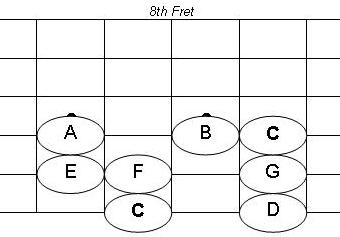In Confession #8 Learn the Major Scale we learned a one octave scale pattern for the major scale, with the root note on the third string.
TWO OCTAVE MAJOR SCALE PATTERN
Today we'll learn a two octave major scale pattern with its root note on the sixth string. The TAB starts on the C at the 8th fret of the sixth string, so this is the C major scale.
 |
| (Click to Enlarge) |
This pattern can be slid up and down the sixth string to play the major scale in different keys. If you were to play this pattern starting on the A at the 5th fret of your sixth string, you would be playing the A major scale.
ISOLATE THE LOWER OCTAVE PATTERN
Let's put the first one octave pattern starting on the sixth string in box format. The root note C, is in bold.
 |
| One octave major scale pattern Root note on sixth string |
The neat thing about this one octave pattern in the first measure is that it can be played starting from a root note on the fifth string, and it will still give us a one octave major scale.
 |
| One octave major scale pattern Root note on fifth string |
FRETBOARD REVELATIONS
Let's compare the one octave pattern in the first measure of the TAB above to the one octave pattern we learned in Confession #8 Learn the Major Scale.
 |
| One octave major scale pattern Root note on sixth string |
 |
| One octave major scale pattern Root note on third string |
These two patterns actually look very similar. The layout of the notes on the:
- the sixth string is the same as on the third string,
- the fifth string is the same as on the second string, and
- the fourth string is the same as on the first string.
The only difference is that when moving up one whole step to switch from the note D to the note E:
- in the first pattern, we have to back 3 frets,
- in the second pattern, we have to go back only 2 frets.
This observation provides some insight into standard tuning:
- On any of strings 6, 5 ,4 or 2, if you move up one string and back 3 frets (i.e. switch from finger 4 to finger 1), that's a whole step.
- On string 3, if you move up one string and back 2 frets, that's a whole step.
- when moving from finger 4 on one string to finger 1 on the next higher string, that's a whole step, and
- when moving from string 3 to string 2, the whole step is one fret closer than it is on the other strings.
Remembering these rules will allow you to build a major scale anywhere on the fretboard. Apply the major scale formula from Confession #8 Learn the Major Scale and then use these rules when switching strings.
Last week's confession, Confession #20 - Palm Muting! (Part 1), has been updated to include a video.
Next Week's Confession - Finger 3-4 Independence! (Ex. #2)
No comments:
Post a Comment